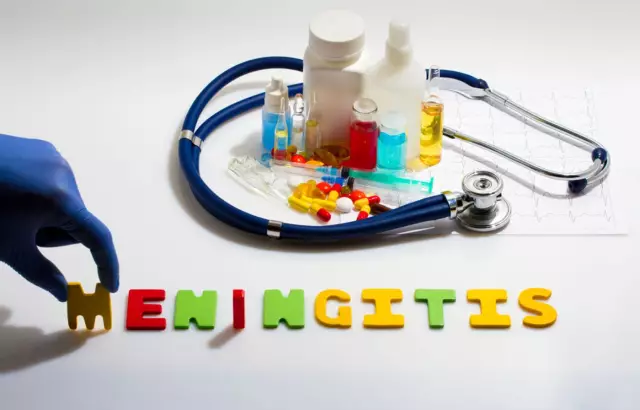- Author Curtis Blomfield [email protected].
- Public 2023-12-16 20:44.
- Last modified 2025-01-23 17:01.
Serous meningitis is an inflammatory process that has developed on the membranes covering the brain and spinal cord. This is displayed on the cerebrospinal fluid in such a way that an increased number of immune cells appears in it. And if during the purulent process most of these cells will be represented by neutrophilic leukocytes, then serous meningitis (signs in the cerebrospinal fluid) is an increase in the cellular composition due to lymphocytes.
What causes this disease

The main cause of serous meningitis is viruses. They can get to a person in various ways. But one penetration into the body is not enough - serous meningitis (signs of it) appears if either the human immunity cannot provide sufficient resistance to the microbe, or the virus turns out to be so aggressive that it can freely overcome its own defenses of the brain.
Some types of serous meningitis are caused by bacteria (tuberculosis bacillus, leptospira, listeria), it can also be caused by fungi (cryptococci) or bacteria-like microbes (rickettsia). In this case, serous meningitis will be secondary, that is, a complication of the generaldiseases.

Serous meningitis: signs
The disease usually begins with catarrhal phenomena: runny nose, cough, pain or sore throat. Body temperature may rise. If serous meningitis is caused by enteroviruses, the symptoms of meningitis itself may precede:
- a reddish rash that evenly covers the entire body, while grouping in the area of the forearms with hands and shins with feet;
- pain and pain in the eyes with their sharp redness;
- severe sore throat;
- loose stools, which usually do not have any impurities of blood and mucus, do not change color.
Signs of viral meningitis may appear on the background of several days of herpes, chickenpox rashes or symptoms of measles, rubella, mumps, in this case the virus needs time to get to the protective brain barrier and pass through it.

Symptoms of meningitis proper include:
- rising temperature;
- a severe headache that is difficult to remove with something, which increases with lifting, active head movements, turns; may increase with nervous tension, watching movies, reading or other load on the visual analyzer;
- nausea and vomiting without diarrhea, but against the background of a headache (less often - back pain);
- pain in the eyes when looking at a light source;
- discomfort if you apply more pressure on the skin in anybody area;
- inability to bring the chin to the sternum in the supine position, when checking this symptom, there is a pulling pain in the neck and back;
- convulsions of varying severity;
- inadequacy;
- lethargy, drowsiness, apathy, which tend to increase.
Sometimes purulent and serous meningitis is difficult to distinguish by clinical manifestations. Only a lumbar puncture, which is necessary for accurate verification of the diagnosis, can help in making the correct diagnosis and prescribing the right treatment.
What to do if you have found serous meningitis (signs of it) in yourself or in a relative?
Be sure to call an ambulance to take you or a loved one to the hospital. Help with meningitis is provided only in a hospital, as this is a deadly and at the same time unpredictable disease, and it is not treated at home.
The diagnosis is made only on the basis of the results of a lumbar puncture, which will be known within an hour and a half after admission to the hospital. This manipulation is very important. It will not only show whether there is meningitis or not, but it will also help to distinguish a purulent variant from a serous one, to assess the degree of its severity, on which therapy directly depends. In addition, after a puncture, it usually becomes easier, and a few drops of CSF sent for bacteriological and serological testing will help determine the type, type of pathogen, and its sensitivity to antimicrobials.
So, if you find in yourself or a loved one signs that match the above,contact the hospital. No forums and online help (especially not a specialist) will help you in diagnosing better than a specialist does.






